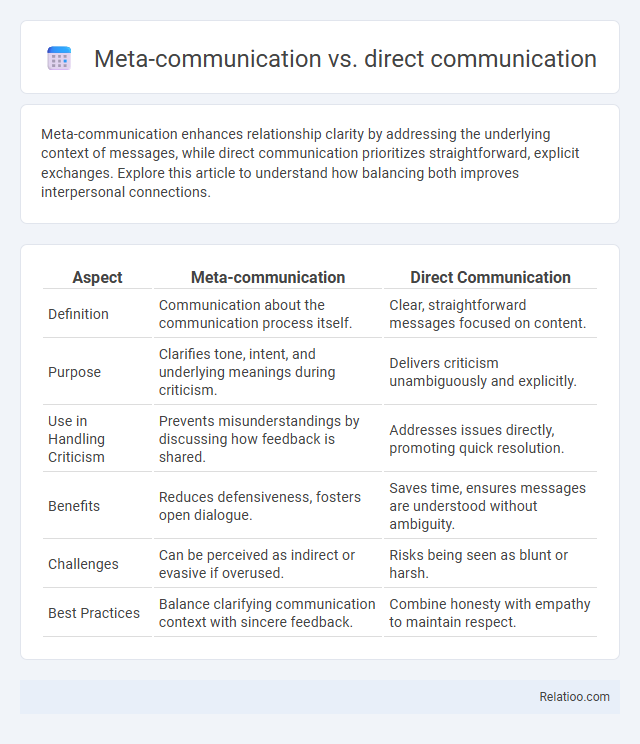Meta-communication enhances relationship clarity by addressing the underlying context of messages, while direct communication prioritizes straightforward, explicit exchanges. Explore this article to understand how balancing both improves interpersonal connections.
Table of Comparison
| Aspect | Meta-communication | Direct Communication |
|---|---|---|
| Definition | Communication about the communication process itself. | Clear, straightforward messages focused on content. |
| Purpose | Clarifies tone, intent, and underlying meanings during criticism. | Delivers criticism unambiguously and explicitly. |
| Use in Handling Criticism | Prevents misunderstandings by discussing how feedback is shared. | Addresses issues directly, promoting quick resolution. |
| Benefits | Reduces defensiveness, fosters open dialogue. | Saves time, ensures messages are understood without ambiguity. |
| Challenges | Can be perceived as indirect or evasive if overused. | Risks being seen as blunt or harsh. |
| Best Practices | Balance clarifying communication context with sincere feedback. | Combine honesty with empathy to maintain respect. |
Understanding Meta-Communication: An Overview
Understanding meta-communication involves recognizing the non-verbal and contextual signals that shape the meaning of direct communication, enhancing clarity and reducing misunderstandings. Unlike direct communication, which conveys explicit messages through words, meta-communication includes tone, gestures, and situational context that influence interpretation. Effective use of meta-communication improves relational dynamics by addressing the underlying emotions and intentions beyond the spoken language.
What is Direct Communication?
Direct communication involves conveying messages clearly and explicitly, minimizing ambiguity to ensure the receiver understands the intended meaning without needing interpretation beyond the literal words. It emphasizes straightforward language, precise instructions, and unambiguous expressions, which enhances efficiency in personal and professional interactions. Unlike meta-communication that analyzes the context or underlying meanings, direct communication relies solely on the explicit content of the message for effective information exchange.
Key Differences Between Meta-Communication and Direct Communication
Meta-communication involves the underlying messages about how communication is happening, often conveying emotions, attitudes, or context beyond the spoken words, whereas direct communication emphasizes explicit, clear, and straightforward information exchange without hidden meanings. The key differences lie in Meta-communication's focus on relational cues and subtext versus direct communication's reliance on unambiguous verbal content. Understanding these distinctions helps you navigate conversations more effectively by interpreting implied messages alongside clear instructions or statements.
Advantages of Meta-Communication
Meta-communication enhances clarity by addressing underlying emotions and intentions beyond the spoken words, reducing misunderstandings in complex interactions. It fosters deeper relational understanding by allowing participants to discuss how they communicate, creating a space for adjustment and mutual respect. This reflective approach guides more effective direct communication, improving conflict resolution and collaboration outcomes.
Benefits of Direct Communication
Direct communication enhances clarity by reducing misunderstandings and ensures that Your message is conveyed precisely to the intended recipient, leading to quicker decision-making and efficient problem-solving. This method fosters transparency and trust in relationships, as the sender expresses thoughts and feelings openly without ambiguity. Unlike meta-communication, which analyzes or discusses communication patterns, direct communication provides immediate, actionable information that drives effective collaboration and task completion.
When to Use Meta-Communication
Meta-communication is most effective when addressing misunderstandings or clarifying the context of a conversation, allowing Your message to be better interpreted without altering its content. Direct communication excels in delivering clear, concise information without ambiguity, ideal for straightforward tasks or instructions. Understanding when to use meta-communication helps prevent conflicts and improves relational dynamics by focusing on how something is said rather than just what is said.
Situations Best Suited for Direct Communication
Direct communication excels in situations requiring clear, concise, and immediate information exchange, such as emergency responses, project deadlines, or straightforward instructions. Your message is conveyed without ambiguity, minimizing misunderstandings and ensuring quick decision-making. This approach is ideal when accuracy and speed are paramount, especially in professional or high-stakes environments.
Common Misunderstandings in Meta-Communication
Meta-communication often leads to common misunderstandings because it involves conveying messages about the communication process itself, which can be subtle and ambiguous compared to direct communication's explicit and straightforward nature. People frequently misinterpret nonverbal cues, tone, or implied meanings in meta-communication, causing confusion or conflict. Clarifying intentions and providing feedback helps reduce misinterpretations between meta-communication and direct communication styles.
Enhancing Workplace Communication: Meta vs Direct Approaches
Enhancing workplace communication involves understanding the differences between meta-communication and direct communication. Meta-communication focuses on the context, tone, and underlying messages beyond spoken words, helping You interpret intentions and improve clarity in team interactions. Direct communication emphasizes clear, explicit language to convey information quickly, but integrating meta-communication strategies can reduce misunderstandings and foster a more collaborative environment.
Choosing the Right Communication Method for Effective Results
Choosing the right communication method hinges on the context and desired outcome; direct communication delivers clear, explicit messages ideal for straightforward tasks and decisions. Meta-communication, which involves discussing the communication process itself, enhances understanding by clarifying intentions, emotions, and underlying meanings, thereby reducing misunderstandings in complex or sensitive interactions. Balancing direct and meta-communication strategies ensures effective results by aligning message clarity with relational awareness, fostering both efficiency and empathy.

Infographic: Meta-communication vs Direct communication
 relatioo.com
relatioo.com